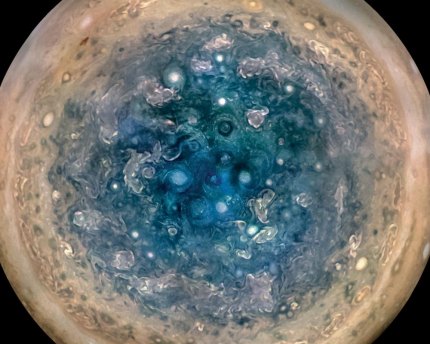Mission yields new, unexpected look at Jupiter

Jupiter's stormy south pole, as seen from the Juno spacecraft.
Image: NASA/Betsy Asher Hall/Gervasio Robles
Much learned about Jupiter so far is not what researchers had expected. The robotic spacecraft Juno launched in 2011 and entered orbit around the planet in 2016. NASA scientists held a press conference Tuesday to discuss the first data-collection pass, which put Juno within about 2,600 miles of Jupiter's cloud tops on Aug. 27.
"The fact that there are the number of cyclones that you see at the poles is really something new that we didn't expect," said Scott Bolton, Juno principal investigator from the Southwest Research Institute in San Antonio. "And the fact that the north and south poles don't really look like each other is also a puzzle to us."
Scientists are now analyzing a band of ammonia around the equator of Jupiter.
"There's a lot of variation with the ammonia in latitude," Bolton said. In fact, Jupiter is all about variation. "If you had stuck in three or four probes in Jupiter at different places, you very well would have gotten three or four different results."
The spacecraft has equipment developed to examine the planet, specifically, the core. Scientists had expected that they would find that Jupiter had either a small, compact core in the center or no core at all. What they found was "a fuzzy core that may be much larger than anybody had anticipated," Bolton said.
Jupiter is approximately 143,000 kilometers (about 89,000 miles) wide at its equator, and according to NASA, more than 1,300 Earths could fit inside of it. So the simple descriptions of its storms are gobsmacking. At one point, researchers were looking at clouds that they estimated to be 50 kilometers (about 31 miles) across. The cyclones near the south pole are 1,000 kilometers (600 miles) in diameter.
The findings are being published this week in two papers in the journal Science, as well as 44 papers in Geophysical Research Letters, according to NASA.
Related:
Juno spacecraft in orbit around Jupiter
Jupiter ready for closeup with Juno mission
Follow StudyHall.Rocks on Twitter.
If you would like to comment, give us a shout, or like us on Facebook and tell us what you think.

